
Richardsonian Romanesque is a style of Romanesque Revival architecture named after the architect Henry Hobson Richardson (1838–1886). The revival style incorporates 11th and 12th century southern French, Spanish, and Italian Romanesque characteristics. Richardson first used elements of the style in his Richardson Olmsted Complex in Buffalo, New York, designed in 1870. Multiple architects followed in this style in the late 1800s; Richardsonian Romanesque later influenced modern styles of architecture as well.
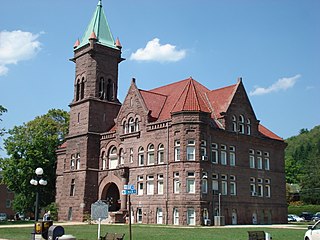
Hummelstown brownstone is a medium-grain, dense sandstone quarried near Hummelstown in Dauphin County, Pennsylvania, USA. It is a dark brownstone with reddish to purplish hues, and was once widely used as a building stone in the United States.

The Suffolk County Courthouse, now formally the John Adams Courthouse, is a historic courthouse building in Pemberton Square in Boston, Massachusetts. It is home to the Massachusetts Supreme Judicial Court and the Massachusetts Appeals Court. Built in 1893, it was the major work of Boston's first city architect, George Clough, and is one of the city's few surviving late 19th-century monumental civic buildings. It was added to the National Register of Historic Places in 1974.

The Amelia S. Givin Free Library is a historic public library in Mount Holly Springs, Cumberland County, Pennsylvania. It was added to the National Register of Historic Places on August 11, 2004.
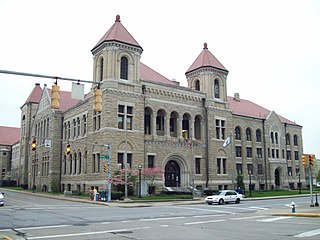
Kanawha County Courthouse is a historic courthouse located at Charleston, West Virginia. It is located across from the Charleston City Hall, and is a block-long structure constructed in 1892 of rock-face masonry.

The U.S. Courthouse & Federal Office Building, Milwaukee, Wisconsin is a post office, Federal office, and courthouse building located at Milwaukee in Milwaukee County, Wisconsin. It is a courthouse for the United States District Court for the Eastern District of Wisconsin.

The Slater Library is the public library of Griswold, Connecticut. It is located in a historic building at 26 Main Street in the borough of Jewett City.

Brookville Presbyterian Church and Manse is a historic Presbyterian church located at White and Main Streets in Brookville, Jefferson County, Pennsylvania, United States. The church was built in 1904-1905, and is a Richardsonian Romanesque-style building built of Hummelstown brownstone. It features two entrances, each set in a loggia, and a square bell tower. The interior is designed in the Akron plan. The manse was built in 1890, and is a brick Second Empire-style dwelling. It features two, 2-story bay windows; a mansard roof; and an open porch.
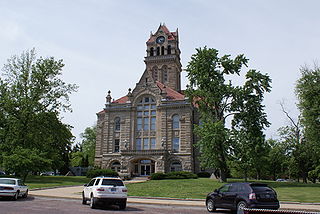
The Starke County Courthouse is a historic courthouse located at Knox, Starke County, Indiana. It was designed by the architectural firm of Wing & Mahurin, of Fort Wayne and built in 1897. It is a three-story, Richardsonian Romanesque style Indiana Oolitic limestone and terra cotta building. It has a Greek cross-plan and is topped by a tiled hipped roof. It features a 138 feet tall clock tower located at the roof's center.

The former Young Men's Christian Association Building in Albany, New York, United States, is located on Pearl Street. It was built in the 1880s in the Romanesque Revival architectural style, with an existing neighboring structure annexed to it and a rear addition built in the 1920s. It was listed on the National Register of Historic Places in 1978. Two years later, when the Downtown Albany Historic District was designated and listed on the Register, YMCA building was further included as a contributing property.

The Wapello County Courthouse in Ottumwa, Iowa, United States, was built in 1894. It was listed on the National Register of Historic Places in 1981 as a part of the County Courthouses in Iowa Thematic Resource. The courthouse is the fourth building the county has used for court functions and county administration. It is part of the Central Park area, which includes: Ottumwa Public Library, Ottumwa City Hall, and St. Mary of the Visitation Catholic Church.

The Hardin County Courthouse, located in Eldora, Iowa, United States, was built in 1892. The courthouse is the third building to house court functions and county administration. It was individually listed on the National Register of Historic Places in 1981. In 2010 it was included as a contributing property in the Eldora Downtown Historic District.

The Bank Street Historic District is a group of four attached brick commercial buildings in different architectural styles on that street in Waterbury, Connecticut, United States. They were built over a 20-year period around the end of the 19th century, when Waterbury was a prosperous, growing industrial center. In 1983 they were recognized as a historic district and listed on the National Register of Historic Places.

Randolph County Courthouse and Jail is a historic courthouse and jail located at Elkins, Randolph County, West Virginia. The two buildings were built between 1902 and 1904. They are constructed of brick and faced with stone with contrasting smooth and textured stone trim. The courthouse measures 103 feet by 76 feet, with a tower flanking the entrance pavilion at 150 feet tall. It features a rounded arch entrance in the Richardsonian Romanesque style. The jail features a massive conical-roofed corner tower.
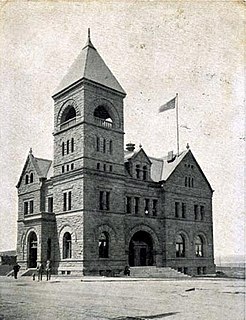
The Old Ashland Post Office is a historic building in Ashland, Wisconsin, United States. It now serves as the Ashland City Hall, which is what most people know it as, and refer to it as. It houses the offices of city government.

The Barry County Courthouse is a government building located at 220 West State Street in Hastings, Michigan. It was designated a Michigan State Historic Site in 1969 and listed on the National Register of Historic Places in 1981.
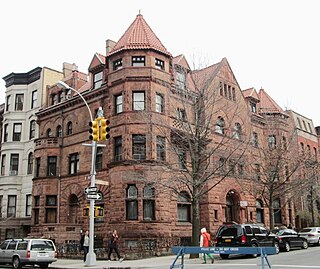
115–119 Eighth Avenue, also known as the Adams House, is a historic house at Eighth Avenue and Carroll Street in Park Slope, Brooklyn, New York City. It was built in 1888 as a double house, and was commissioned by Thomas Adams Jr., who invented the Adams Chiclets automatic vending machine. It was designed by noted architect C. P. H. Gilbert in the Richardsonian Romanesque style, and is considered to be one of the best examples of that style extant in New York City, "worthy of H. H. Richardson." The house is built of sandstone, terra cotta and brick on a brownstone base, and was the first house in the neighborhood with an elevator. It has now been converted into apartments.

The Hugh Roy and Lillie Cullen Building is the central administration building of Southwestern University in Georgetown, Texas. Completed in 1900, the Cullen Building was declared a Recorded Texas Historic Landmark in 1962 and has been listed on the National Register of Historic Places since 1975, together with neighboring Mood-Bridwell Hall.

The University of Michigan Central Campus Historic District is a historic district consisting of a group of major buildings on the campus of the University of Michigan in Ann Arbor, Michigan. It was listed on the National Register of Historic Places in 1978.

The Howell Downtown Historic District is a primarily commercial historic district located along five blocks of Grand River Avenue in the center of Howell, Michigan. It was listed on the National Register of Historic Places in 1987.























